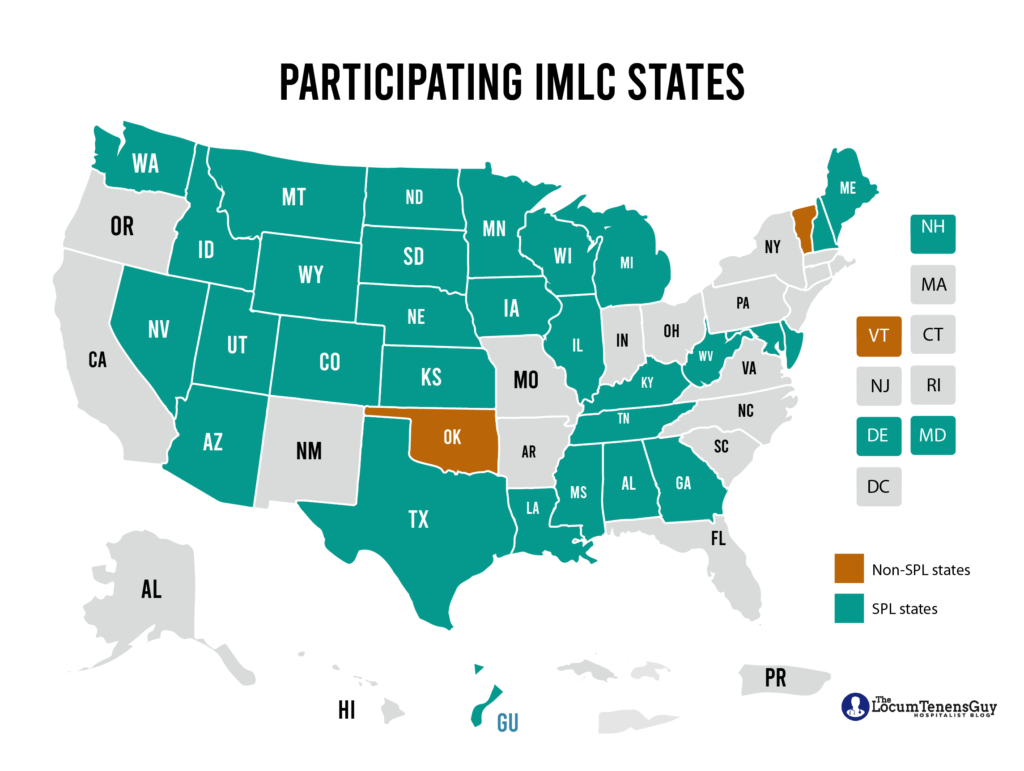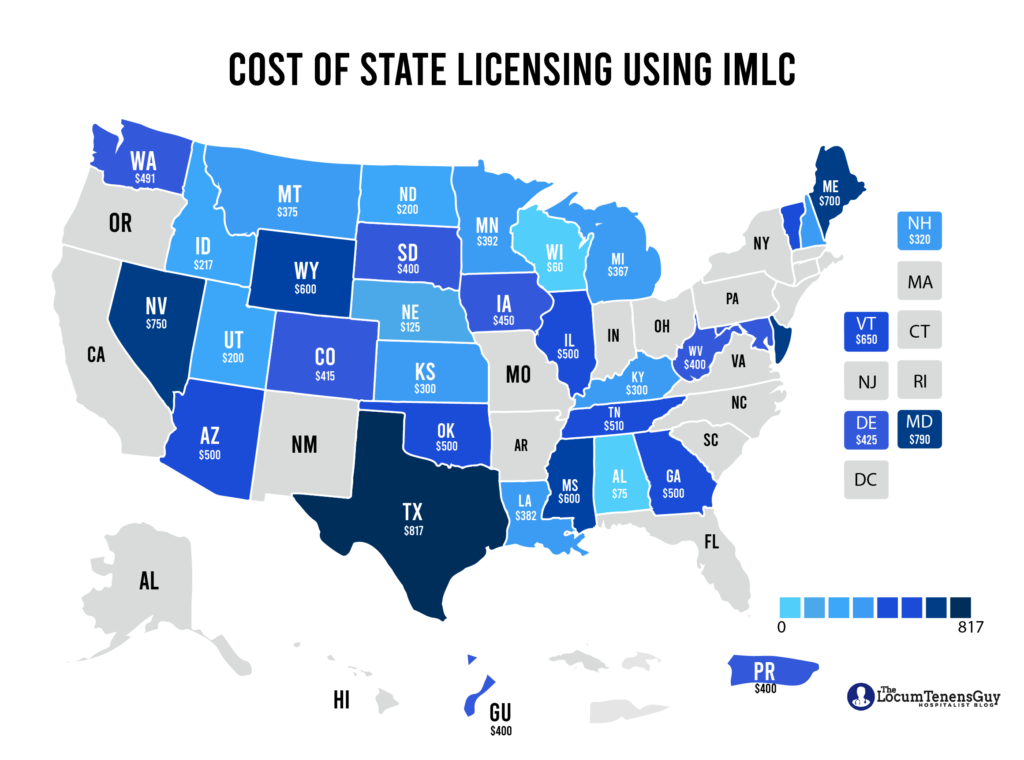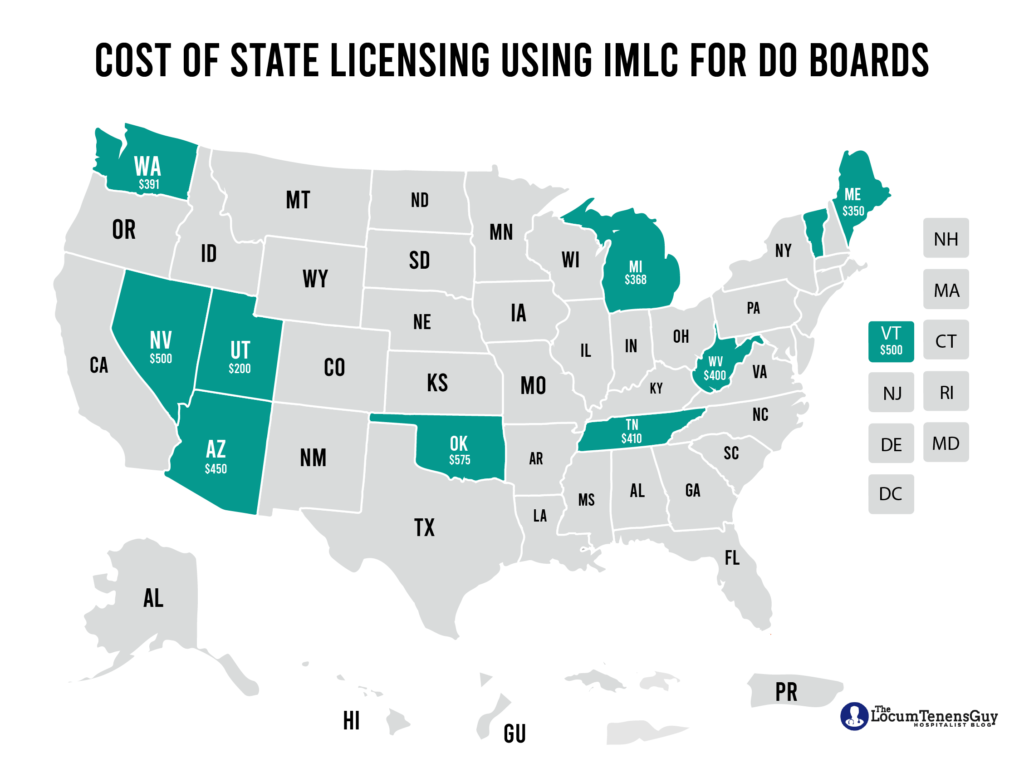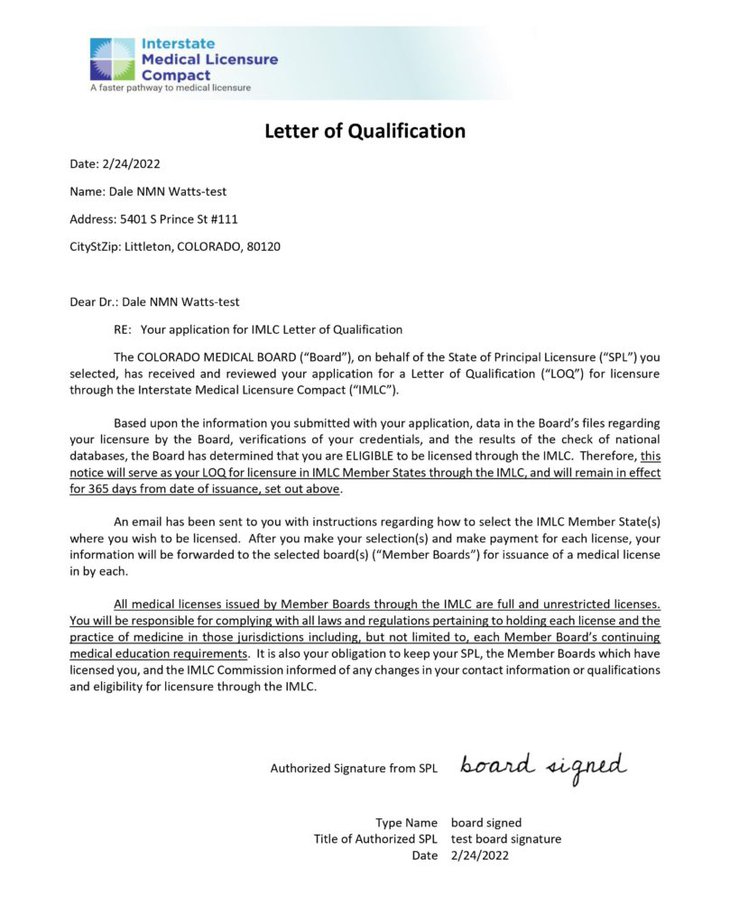

Vlad Dzhashi, MD
Interstate Medical Licensure Compact (IMLC) is a true game changer for physicians. It lets doctors apply for dozens of medical licenses using a single application and as a result it can save months of their time.
Sounds too good to be true?
I know, I know…
It may feel that way, but if you give a few minutes of your time, I’ll walk you through the IMLC process and you’ll realize it’s actually pretty straightforward.
This guide will give you everything you need to know from eligibility, cost, timeline, participating states to the pitfalls you want to avoid.
Let’s dive right into it!
What is the Interstate Medical Licensure Compact?
How does IMLC work?
IMLC eligibility requirements
In order to qualify for the IMLC licensing pathway, physicians should meet several requirements.
#1: Physician must be board-certified
#2: Physician must “hold a full, unrestricted medical license in a Compact member-state that can serve as a declared State of Principal License (SPL)”.
#3: Physician must ensure that at least ONE of the following apply:
- The physician’s primary residence is in the SPL
- At least 25% of the physician’s practice of medicine occurs in the SPL
- The physician is employed to practice medicine by a person, business or organization located in the SPL
- The physician uses the SPL as his or her state of residence for U.S. Federal Income Tax purposes
- Not have any history of disciplinary actions toward your medical license
- Not have any criminal history
- Not have any history of controlled substance actions toward your medical license
- Not currently be under investigation
Using IMLC with malpractice history
Now, one of the questions that some of us may be wondering about is whether malpractice history would disqualify physicians from the IMLC.
Unfortunately, I couldn’t find any information on the official IMLCC website, so I reached out to the IMLC and WA state medical board directly to clarify and here are the responses that I got.
WA state medical board’s response:
“Past malpractice is accepted through the IMLC, any ongoing cases or board actions would disqualify.”
IMLC response:
“Malpractice would only be a disqualifier if a medical board has an open active investigation or has issued discipline based on the malpractice report.”
As you can see, the responses are somewhat conflicting.
The IMLC suggested that an open malpractice case is not an issue as long as your respective medical board didn’t open an investigation.
WA state medical board on the other hand stated that you can use IMLC as long as your malpractice case is closed.
My suggestion is to reach out to your respective medical board before applying as it’s up to them to decide if you’re eligible or not.
What states participate in IMLC? Compact states
Now let’s talk about participating IMLC states.
There are currently 32 Compact states accepting applications as a part of the IMLC pathway (this includes Guam).

Here are the Compact states:
- Alabama
- Arizona
- Colorado
- Delaware
- Georgia
- Guam
- Iowa
- Idaho
- Illinois
- Kansas
- Kentucky
- Louisiana
- Maryland
- Maine
- Michigan
- Minnesota
- Mississippi
- Montana
- North Dakota
- Nebraska
- New Hampshire
- Nevada
- Oklahoma
- South Dakota
- Tennessee
- Texas
- Utah
- Vermont
- Washington
- Wisconsin
- West Virginia
- Wyoming
States of principal licensure (SPL) vs. Non-SPL States
State of Principal Licensure (SPL) is a state where you hold an unrestricted license and use it as your primary state to apply for other licenses within the IMLC pathway.
If you work and live in multiple states, you can use either one as your primary state as long as you’re eligible (see eligibility requirements).
Non-SPL states can’t be used as primary “sponsoring” states during the application process. However, doctors who have a qualification letter from any SPL state can be issued licenses from non-SPL states. Currently there are only two non-SPL states: Oklahoma and Vermont.
Future State Board Participation:
Now, the good news is that the list of IMLC states keeps expanding and after passing legislation to join the IMLC, the following states are in the process of joining.
- District of Columbia
- Connecticut
- Indiana
- New Jersey
- Ohio
- Pennsylvania
With that said, it’s unclear as to when these states are going to officially become a part of the IMLC.
These additional states are awaiting legislation proceedings to join:
- Massachesets
- Missouri
- North Carolina
- Rhode Island
- Virginia
Cost of Interstate Medical Licensure Compact
Surprisingly, the cost of Interstate Medical Licensure Compact is not that high, especially if you consider the amount of time you’re saving.
That said, the fees aren’t refundable (!!!) so make sure you understand the application’s eligibility criteria to avoid being charged if you don’t qualify.
The IMLC Compact fee is $700 plus the license cost of the issuing state, as shown in the maps below.


To understand the costs involved, let’s look at the example of applying to practice in Colorado and Wyoming.
- Colorado $415 fee
- + Wyoming’s $600 fee
- + IMLC application $700
- Fingerprinting and postage – under $100
- = $1,815.
Note that you’ll have to pay additional fees for fingerprinting and postage, which will be typically under $100.
IMLC application process
The IMLC application process is pretty straightforward, just follow these steps:
1 – Check the map first: I know, It may’ve been a long winter and you’re thinking of working in Hawaii, but the aloha state isn’t on the IMLC map. Neither is Florida, California and many other states.
2 – Make sure you’re eligible, check these guidelines.
3 – Once you have all the pertinent information, click on the IMLC website Apply Portal.
4 – The website application will prompt you to choose the SPL (home or primary state). This state must be a Compact participant and processes the application.
5 – Complete all the fields on the short application form and provide the correct details to the Compact. Pay the $700 fee when prompted. An electronic receipt will follow your email.
6 – Next you’ll get instructions on how to obtain fingerprints.
7 – If your credentials meet the criteria and your background check is successful, you’ll be able to download the Letter of Qualification (sample letter in the next section).
8- Then, you can select the states you need licenses in and pay the applicable state fees
9 – Sometimes, the issuing state medical board may require additional documents as each state has its own unique method.
IMLC letter of qualification (LOQ)
Letter of qualification (LOQ) is a document physicians receive once they complete the IMLC application process. It’s valid for 12 months and allows you to apply for any license(s) with the participating medical boards.
You can add licenses as soon as you get approved or add licenses letter within a 12 month period.
Here’s an example of the Letter of Qualification that you’ll receive:
IMLC licensing timeframe
Using the IMLC allows you to get your licenses very quickly. Usually, in a few weeks your license(s) will be issued and you can hit the road to your new destination.
IMLC license renewal
To renew your licenses received through Compact, your information will have to be verified by your primary medical board and you’ll have to pay the application and state license fees again.
To renew your licenses received though Compact, go to the IMLC website and click the Renew tab and follow the prompt.
Now, let’s see who would benefit from using the IMLC the most.
IMLC for locum tenens
Interstate Medical Licensure Compact is a great “shortcut” if you work locums as you can get multiple licenses within a few weeks. This will significantly expand the number of states you can work and you can secure new locum tenens gig fast.
Of course, some of the largest and popular states among locums doctors like New York, California, Florida are not part of the IMLCC, so if you’re interested in working in those states, you’ll still have to use a traditional way to apply for locum tenens license to add them to your “collection”.
IMLC for telemedicine:
IMLC can be a game changer for telemedicine docs as well. Just keep in mind that IMLC is not in itself a “telemedicine” license and each medical board will be issuing you a conventional license.
Hence, you’re still paying a lot of money for new license issuance and renewals.
IMLC Pitfalls
- Potential issues with IMLC
- Additional documents may be requested by the issuing board
- Letter of Qualification is only valid for 365 days
- You must maintain your primary state’s license to maintain other licenses issued by Compact
- You may not be able to obtain a license using IMLC if you’ve held it in the past
- You must be Board-Certified to qualify
- Application fee is non-refundable
Extra documents may be required by the issuing board:
Nothing is ever that easy. You applied and received the LOQ but the governing medical board wants additional documents. Of course, this will mean a longer timeframe and more work on your end.
One year rule for Letter of Qualification (LOQ):
Letter of Qualification is only valid for 365 days since it’s issued, so if you decide to add more licenses after it’s expired, you’ll have to go through the same process (with the exception of the board certification verification) and pay a $700 fee.
I definitely think this period could be longer, let’s say two or three years (similar to the standard medical license duration) as the one year rule may “force” doctors to apply for too many licenses “just in case” and potentially wasting money on licenses they don’t really need.
Changing the State of Principal License:
Another important point that doctors are missing is that in order to keep all your IMLC licenses you have to maintain your respective state license (i.e. “primary license”). In other words, If you ever let your “home” state license lapse, you’ll lose all licenses issued through the Compact.
Having said that, you can change or redesignate the SPL state for free.
On the website, in the GO bar, click on “Redesignate”. After completing the form, the new SPL and the old SPL state will be notified.
Using IMLC to renew expired license you previously obtained outside of the Compact:
Everyone forgets about expired licenses.
You see, if you’ve ever got a state medical license using “conventional” pathway (not IMLC) and your license has expired, the board may not allow you to use the Compact for renewal and instead, may require you to proceed using a reinstatement.
Board certification rule:
The board certification rule is simple: you don’t qualify for the IMLC pathway unless you’re board certified.
It’s unclear why this rule was created, and I believe that board-eligible doctors should be allowed to use IMLC the same way they are allowed to take care of the patients.
Your application fee is non-refundable.
Can’t stress this enough: do your homework before applying, otherwise it’s like tossing $700+ in the trash.
When in doubt, reach out to your state’s IMLCC agent using the contact info below.
How to contact IMLC:
I’ve done my best to answer all possible questions regarding the IMLC to get you on the right track. With that said, feel free to reach out to the IMLC with any questions.
👉There are a few ways to do that:
- IMLC website: https://www.imlcc.org/
- IMLC general inquiries email: [email protected],
- IMLC phone number: 303-997-9842
- Connect with your primary state’s representative.
My experience is that you can usually get a response in 24-48 hours.
Interstate Medical Licensure Compact key takeaways:
- Key benefits:
- Easy application system
- Quick, expedited licensure process
- Ability to apply for up to 31(!!!) licenses using a single application
- The list of participating states is growing and hopefully will eventually include all states and US territories
The IMLC pathway is an ideal way to explore this great country whether you work locums, telemedicine or need to quickly apply for multiple state licenses at once.

